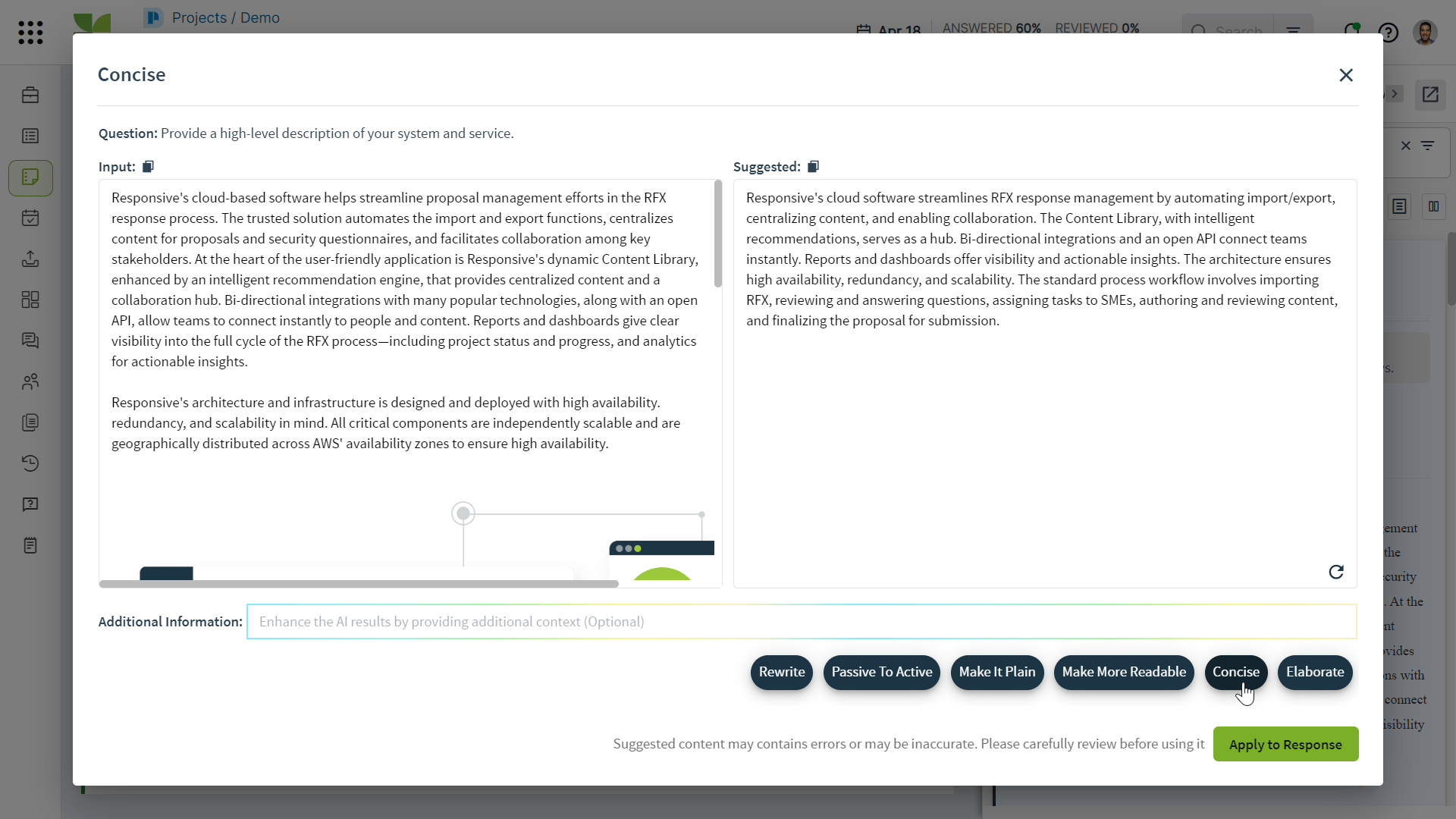Data Axle is a 50-year-old data-driven marketing agency who helps Fortune 500 companies find new customers and be more relevant to their existing customers. It’s a complex business that, as you’d expect, requires complex request for proposals (RFP). When the company’s growth started to demand more automation, the Sales Enablement team seized the opportunity to develop a better process for RFP responses—one that actually took advantage of the features Responsive offered—and ended up developing a dynamic response management process that is now used for RFPs, RFIs, and other client-requested information.
Data Axle results to date:
- Respond to RFPs 30-50% faster
- Sales Enablement team answers up to 80% of questionnaires before reaching out to SMEs
- Happier users as a result of simplified content governance
Prepping Content Library for self-service
Data Axle has multiple divisions, has made multiple acquisitions, and—like any business—has new employees that need to be quickly brought up to speed on the business.
While they had a large Responsive Content Library that could theoretically simplify the process of responding to RFPs, in practice, it wasn’t working out that way. The library contained thousands of pieces of content, but they were stale. Nobody was making updates to keep the information current, and few of the staff had access to it anyways. When someone needed help, they would skip right past the library and go straight to product owners or subject matter experts (SMEs) for help.
“We decided to start with the Content Library,” Tiffany Ramos, Data Axle Sales Enablement Manager, explains. “[So employees] could self-serve with company information, product-level content, and then all of our services content.” Doing that required making sure the content was both current and well organized.
For the first part, the Sales Enablement team started to assign SMEs content updates on a rolling schedule. Experts are tasked with reviewing around ten items of content each month to check for currency and make any needed updates.
Creating (and maintaining) a single source of truth
They also redid custom fields at the Responsive Project level, to help with the counts that the company information sections of RFPs regularly require. The number of employees, customers, and business records in their database are all things that change frequently. By using custom fields and creating a regular process for updates, they only have to modify the information in one place to know the current information will then show up everywhere else.
To improve the way their content is organized, they shifted from using question-and-answer formatting to having content devoted to larger topics. They include all the relevant questions and answers for that topic on one page, so it’s easier for users to find the information they need in one place. That reduces the size of the Content Library, but still allows users to search for any alternative questions not covered on the page.
All of that has ensured users can easily find the content they need quickly. And even better, they don’t have to worry about the information’s accuracy.
Educating everyone to use the Content Library
With a comprehensive, accurate Content Library in place, the next challenge is getting everyone to use it.
First, they wanted to make sure everyone in the organization could access the library. Responsive’s unlimited user license model made that possible. Next, Sales Enablement added a Content Library course to the standard onboarding process.
Not only do they educate everyone to know where the Content Library is and how it works, but org settings are updated so that every time a seller or account manager logs in, they go straight to the Content Library. That ensures they never forget it’s there when they need it.
And it’s worked. People in the company often turn to the Content Library first when they need information. As soon as SMEs are assigned questions to answer for an RFP, they head over to the Content Library to find any past answers to work from. That’s much more efficient than writing each answer from scratch.
Creating a feedback loop to keep improvements coming
While the new process has been a big step up from how things worked before, maintaining a dynamic Content Library is ongoing. Content changes and use cases for the Content Library expand as more users are exposed to its capabilities. Data Axle recognizes that there’s always room for improvement. So they make a point of soliciting feedback and making changes based on what they learn.
They have regular conversations with users to learn what they like and don’t like about the product and process. And when they hear suggestions for ways to make it better, they jump in and do it.
Tiffany also notes that she loves being on the other side of that feedback loop with Responsive as well. “We appreciate the fact that Responsive will make adjustments to the solution based on user feedback,” she says. “I love that. I get so excited when one of my changes has been implemented.”
Gaining traction with happier users
A big technology challenge that companies routinely face is getting employees to actually use the products they buy. With Responsive though, employees are happy enough with the product to make this a non-issue.
Tiffany keeps an eye on the usage statistics and sees plenty of evidence of the difference the tool makes, including positive feedback from users.
Multiple SMEs have also volunteered that Responsive makes it easy to update content. Much of the positive user response can also be attributed to the sales enablement team’s consistent outreach and promotion of Responsive and its benefits.
Between Responsive’s performance and sales enablement’s non-stop championing, not one user has complained about the new response management process. With 300 Responsive users in the company, a complete lack of complaints is saying something.
Accelerating the RFP process
“All of this in conjunction has helped us be able to answer RFPs quicker,” Tiffany says. Data Axle has seen a 30-50% improvement in how quickly they complete their RFPs. And they don’t just meet more deadlines now, they often beat them. Crucially, none of that speed comes at the expense of losing accuracy.
As a nice bonus, the faster process leaves the Sales Enablement team open to help out with other client-requested information and questionnaires. Prior to the rollout of the Content Library, employees would send any other client-requested information and questionnaires to a specified email address, which felt like passing them over to a black hole. Now, Sales Enablement has taken over the process and they’re able to answer around 80% of the questionnaires they receive. And they can manage about a third of all the answers themselves, without needing additional help. That leaves the SMEs more time to focus on other priorities.
| Before active Responsive engagement | After active Responsive engagement |
| RFP responses were often rushed and submitted just before the deadline. | RFPs are completed 30-50% faster and often submitted before deadlines. |
| Content library grew unchecked, becoming messy and difficult to search efficiently. | Assigned SMEs to rolling content reviews and implemented content management processes to reduce library size and ensure accuracy. |
| Responders dreaded RFPs coming in. | Responders have confidence that the processes and content are reliably managed through Responsive. |
| Client-requested information and questionnaires needed to go to an e-mail address that felt like passing them over to a black hole. | The Sales Enablement team has taken over the process and now answers around 80% of the questionnaires they receive. |
Responsive comes out as the due diligence review winner every year
Completely reorganizing a process like this requires a lot of work. But it has paid off for Data Axle.
Data Axle also recently launched Responsive® LookUp in their instance. Employees can use Responsive LookUp to respond to client questions so they don’t have to toggle between the Responsive application and the application they’re already using. To help ensure a successful rollout of Responsive LookUp, an internal email promotional campaign informed users about the new benefits and instructed them on how to use it.
Data Axle knows better than to get complacent. As happy as they are with Responsive and their current process now, they’re open to change—if they see a better way of doing things.
“We do our due diligence each year on what’s out there in the marketplace,” Tiffany noted. ”But each year it’s clear that Responsive surpasses the other solutions to meet our needs.”
“While no solution may be perfect, getting things 90% complete before exporting responses is wonderful,” she adds.
About Data Axle
Data Axle is a leading provider of data, data-driven marketing and real-time business intelligence solutions for enterprise, small business, nonprofit and political organizations. The company’s solutions and award-winning Axle Agency enable clients to acquire and retain customers and enhance their user experiences through proprietary business and consumer data, artificial intelligence/machine learning models, innovative software applications and expert professional services. Data Axle’s cloud-based platform delivers data and data updates in real-time via APIs, CRM integrations, SaaS and managed services. Data Axle has 50+ years of experience helping organizations exceed their goals. For more information, visit www.data-axle.com.






